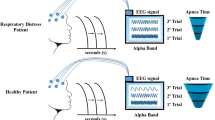Abstract
The correct ventilation for patients in intensive care units plays a critical role for the prognostic and the recovery during the stay in the hospital. Desynchronization between the ventilator and the patient is an important source of stress, emphasized by the lack of communication due to intubation or loss of consciousness. This contribution proposes a novel approach based on electroencephalographic (EEG) activity to detect breathing effort. Relying both on recent neuroscience finding on respiratory-related evoked potential and on latest development of information geometry, the proposed approach elaborates on Riemannian distances between EEG covariance matrices to differentiate among different respiratory loads. The results demonstrate that this approach outperform existing state-of-the-art methods quantitatively, in terms of mean accuracy, and qualitatively, being able to predict level of breathing discomfort.
Access this chapter
Tax calculation will be finalised at checkout
Purchases are for personal use only
Similar content being viewed by others
References
Barachant, A., Bonnet, S., Congedo, M., Jutten, C.: Multiclass brain-computer interface classification by Riemannian geometry. IEEE Trans. Biomed. Eng. 59(4), 920–928 (2012)
Blanch, L., et al.: Validation of the better care® system to detect ineffective efforts during expiration in mechanically ventilated patients: a pilot study. Intensiv. Care Med. 38(5), 772–780 (2012)
Blankertz, B., Tomioka, R., Lemm, S., Kawanabe, M., Muller, K.R.: Optimizing spatial filters for robust EEG single-trial analysis. IEEE Signal Process. Mag. 25(1), 41–56 (2008)
Congedo, M., Barachant, A., Bhatia, R.: Riemannian geometry for EEG-based brain-computer interfaces; a primer and a review. Brain-Comput. Interfaces 4, 1–20 (2017)
Congedo, M., Barachant, A., Andreev, A.: A new generation of brain-computer interface based on Riemannian geometry. arXiv preprint arXiv:1310.8115 (2013)
Dres, M., Rittayamai, N., Brochard, L.: Monitoring patient-ventilator asynchrony. Curr. Opin. Crit. Care 22(3), 246–253 (2016)
Dubois, M., et al.: Neurophysiological evidence for a cortical contribution to the wakefulness-related drive to breathe explaining hypocapnia-resistant ventilation in humans. J. Neurosci. 36(41), 10673–10682 (2016)
Esteban, A., et al.: How is mechanical ventilation employed in the intensive care unit? An international utilization review. Am. J. Respir. Crit. Care Med. 161(5), 1450–1458 (2000)
Fatourechi, M., Ward, R.K., Mason, S.G., Huggins, J., Schlögl, A., Birch, G.E.: Comparison of evaluation metrics in classification applications with imbalanced datasets. In: International Conference on Machine Learning and Applications (ICMLA), pp. 777–782. IEEE (2008)
Hudson, A.L., et al.: Electroencephalographic detection of respiratory-related cortical activity in humans: from event-related approaches to continuous connectivity evaluation. J. Neurophysiol. 115(4), 2214–2223 (2016)
Kalunga, E.K., Chevallier, S., Barthélemy, Q., Djouani, K., Monacelli, E., Hamam, Y.: Online SSVEP-based BCI using riemannian geometry. Neurocomputing 191, 55–68 (2016)
Kalunga, E.K., Chevallier, S., Barthélemy, Q., Djouani, K., Hamam, Y., Monacelli, E.: From euclidean to riemannian means: information geometry for SSVEP classification. In: Nielsen, F., Barbaresco, F. (eds.) GSI 2015. LNCS, vol. 9389, pp. 595–604. Springer, Cham (2015). https://doi.org/10.1007/978-3-319-25040-3_64
Knafelc, M., Davenport, P.W.: Relationship between magnitude estimation of resistive loads, inspiratory pressures, and the rrep p1 peak. J. Appl. Physiol. 87(2), 516–522 (1999)
Lotte, F., et al.: A review of classification algorithms for eeg-based brain-computer interfaces: a 10 year update. J. Neural Eng. 15(3), 031005 (2018). http://stacks.iop.org/1741-2552/15/i=3/a=031005
Mayaud, L., et al.: Brain-computer interface for the communication of acute patients: a feasibility study and a randomized controlled trial comparing performance with healthy participants and a traditional assistive device. Brain-Comput. Interfaces 3(4), 197–215 (2016)
Moakher, M.: A differential geometric approach to the geometric mean of symmetric positive-definite matrices. SIAM J. Matrix Anal. Appl. 26(3), 735–747 (2005)
Navarro-Sune, X., et al.: Riemannian geometry applied to detection of respiratory states from EEG signals: the basis for a brain-ventilator interface. IEEE Trans. Biomed. Eng. 64(5), 1138–1148 (2017)
Piquilloud, L., et al.: Neurally adjusted ventilatory assist (NAVA) improves patient-ventilator interaction during non-invasive ventilation delivered by face mask. Intensiv. Care Med. 38(10), 1624–1631 (2012)
Reuter, B., Linke, D., Kurthen, M.: Cognitive processes in unconscious patients? A brain mapping study of the p300 potential. Archiv fur Psychologie 141(3), 155–173 (1989)
Rivet, B., Souloumiac, A., Attina, V., Gibert, G.: xDAWN algorithm to enhance evoked potentials: application to brain-computer interface. IEEE Trans. Biomed. Eng. 56(8), 2035–2043 (2009)
Rotondi, A.J., et al.: Patients’ recollections of stressful experiences while receiving prolonged mechanical ventilation in an intensive care unit. Critical Care Med. 30(4), 746–752 (2002)
Schäfer, J., Strimmer, K.: A shrinkage approach to large-scale covariance matrix estimation and implications for functional genomics. Stat. Appl. Genet. Mol. Biol. 4(1) (2005)
Scholkopf, B., Smola, A.J.: Learning with Kernels: Support Vector Machines, Regularization, Optimization, and Beyond. MIT Press, Cambridge (2001)
Wolpaw, J., Birbaumer, N., McFarland, D.J., Pfurtscheller, G., Vaughan, T.M.: Brain-computer interfaces for communication and control. Clin. Neurophysiol. 113(6), 767–791 (2002)
Yger, F., Berar, M., Lotte, F.: Riemannian approaches in brain-computer interfaces: a review. IEEE Trans. Neural. Syst. Rehabil. Eng. 25(10), 1753–1762 (2017)
Author information
Authors and Affiliations
Corresponding author
Editor information
Editors and Affiliations
Rights and permissions
Copyright information
© 2018 Springer Nature Switzerland AG
About this paper
Cite this paper
Chevallier, S. et al. (2018). Brain-Machine Interface for Mechanical Ventilation Using Respiratory-Related Evoked Potential. In: Kůrková, V., Manolopoulos, Y., Hammer, B., Iliadis, L., Maglogiannis, I. (eds) Artificial Neural Networks and Machine Learning – ICANN 2018. ICANN 2018. Lecture Notes in Computer Science(), vol 11141. Springer, Cham. https://doi.org/10.1007/978-3-030-01424-7_65
Download citation
DOI: https://doi.org/10.1007/978-3-030-01424-7_65
Published:
Publisher Name: Springer, Cham
Print ISBN: 978-3-030-01423-0
Online ISBN: 978-3-030-01424-7
eBook Packages: Computer ScienceComputer Science (R0)




